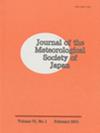Validation of MODIS and AHI Observed Water Cloud Properties Using Surface Radiation Data
IF 1.6
4区 地球科学
Q3 METEOROLOGY & ATMOSPHERIC SCIENCES
引用次数: 9
Abstract
The present study implements long-term surface observed radiation data (pyranometer observed global flux and sky radiometer observed spectral zenith transmittance data) of multiple SKYNET sites to validate water cloud optical properties (cloud optical depth COD and effective radius Re) observed from space by MODIS onboard TERRA and AQUA satellites and AHI onboard Himawari-8 satellite. Despite some degrees of differences in COD and Re between MODIS and AHI, they both showed common features when validated using surface based global flux data as well as cloud properties retrieved from sky radiometer observed zenith transmittance data. In general, CODs from both satellite sensors are found to overestimated when clouds are optically thin. Among a number of factors (spatial and temporal variations of cloud, sensor and solar zenith angles), the solar zenith angle (SZA) is found to have an impact on COD difference between reflectance based satellite sensor and transmittance based sky radiometer. The Re values from the sky radiometer and satellite sensor are generally poorly correlated. The difference in Re between the sky radiometer and satellite sensor is negatively correlated with COD difference between them, which is likely due to the inherent influence of Re retrieval precision on COD retrieval and vice versa in transmittance based sky radiometer.利用地表辐射资料验证MODIS和AHI观测的水云性质
本研究利用多个SKYNET站点的长期地表观测辐射数据(高强计观测到的全球通量和天空辐射计观测到的光谱天顶透射率数据),验证TERRA和AQUA卫星上的MODIS和Himawari-8卫星上的AHI从太空观测到的水云光学特性(云光学深度COD和有效半径Re)。尽管MODIS和AHI在COD和Re方面存在一定程度的差异,但当使用基于地表的全球通量数据以及从天空辐射计观测到的天顶透射率数据中检索到的云特性进行验证时,两者都显示出共同的特征。一般来说,当云的光学厚度较薄时,两个卫星传感器的cod都被高估了。在云层、传感器和太阳天顶角的时空变化等因素中,太阳天顶角(SZA)对基于反射率的卫星传感器和基于透射率的天空辐射计的COD差异有重要影响。来自天空辐射计和卫星传感器的Re值通常相关性很差。天空辐射计和卫星辐射计的Re差与两者之间的COD差呈负相关,这可能是由于Re反演精度对COD反演的固有影响,而基于透射率的天空辐射计则相反。
本文章由计算机程序翻译,如有差异,请以英文原文为准。
求助全文
约1分钟内获得全文
求助全文
来源期刊
CiteScore
6.70
自引率
16.10%
发文量
56
审稿时长
3 months
期刊介绍:
JMSJ publishes Articles and Notes and Correspondence that report novel scientific discoveries or technical developments that advance understanding in meteorology and related sciences. The journal’s broad scope includes meteorological observations, modeling, data assimilation, analyses, global and regional climate research, satellite remote sensing, chemistry and transport, and dynamic meteorology including geophysical fluid dynamics. In particular, JMSJ welcomes papers related to Asian monsoons, climate and mesoscale models, and numerical weather forecasts. Insightful and well-structured original Review Articles that describe the advances and challenges in meteorology and related sciences are also welcome.

 求助内容:
求助内容: 应助结果提醒方式:
应助结果提醒方式:


